These days, home design keeps pushing the boundaries between indoor and outdoor spaces. More and more, people want their living areas to flow right from inside to out—spaces that feel close to nature but still cozy and practical.
Remember to repin your favorite images!
When you create a seamless indoor-outdoor connection, it’s not just about looks. It actually makes life better, expanding how you use your home and letting you enjoy natural elements every day.
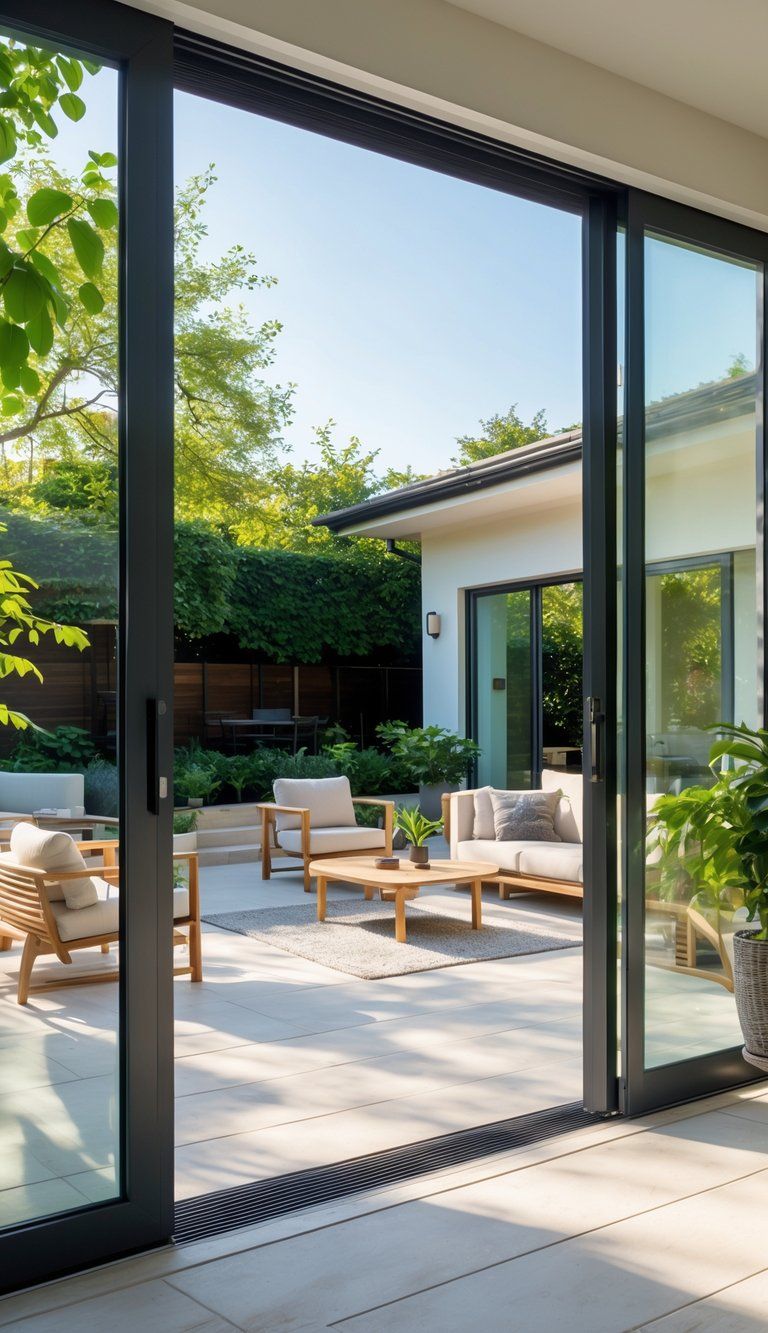
The secret to great indoor-outdoor design? Thoughtful transitions. When you line up indoor and outdoor spaces with similar functions, everything just flows.
Picture your patio as part of your living room, or your deck as an extra kitchen zone. If you keep the look and purpose consistent, those boundaries start to disappear.
Materials matter a lot here. Use the same flooring inside and out, add big sliding doors that tuck away, or pick furniture that fits both spaces. Suddenly, it all feels unified.
Weather-resistant fabrics, UV-proof materials, and smart lighting make these areas usable no matter the season or time. It’s honestly a game-changer.
Understanding Indoor-Outdoor Connection
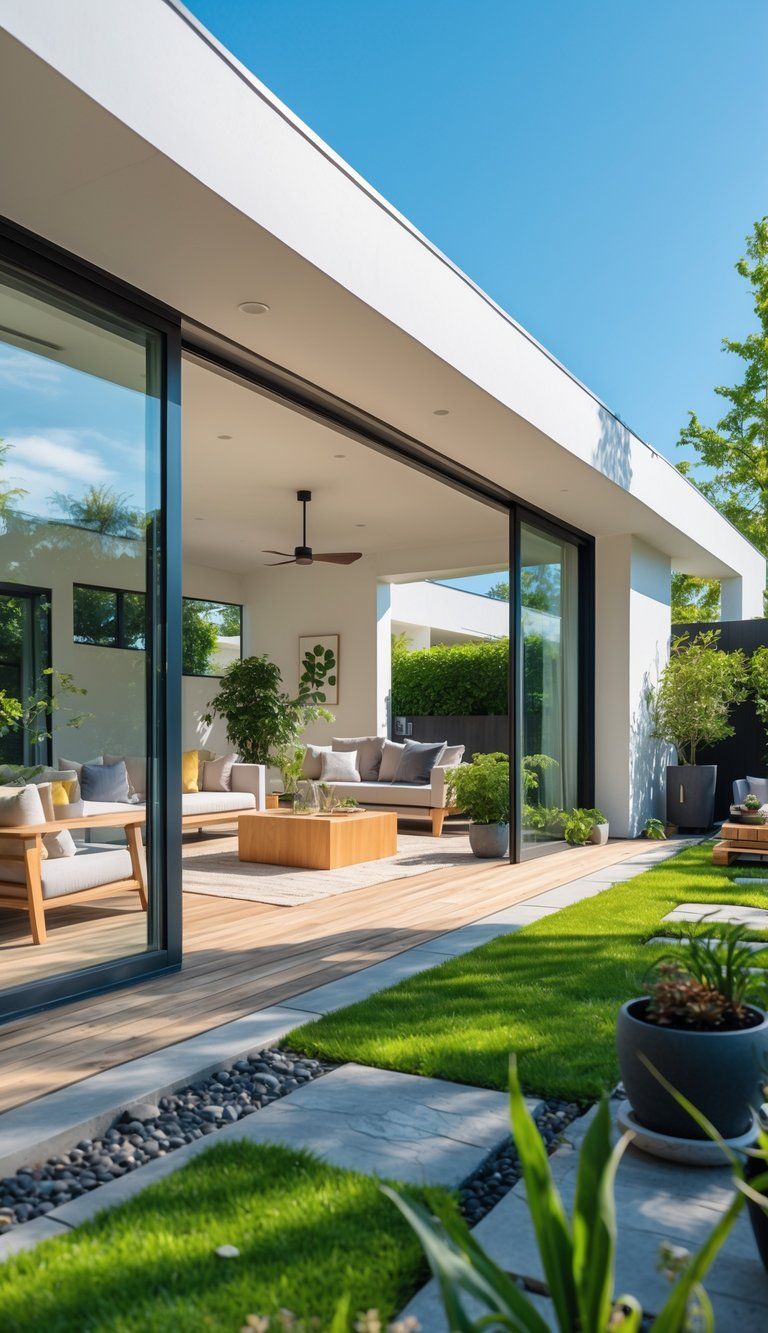
When you blend interior and exterior spaces, you change your whole experience at home. These connections blur boundaries and bring in more light, making your place feel bigger without adding any square footage.
What Is an Indoor-Outdoor Connection?
An indoor-outdoor connection uses design to link your home’s inside with your outside spaces, both visually and functionally. It’s not just about having a door to the yard.
A true connection means you move smoothly from one space to the next. It might look like:
- Big glass doors that open all the way
- Flooring that runs from inside to outside
- Matching ceiling heights and rooflines
- Similar colors and materials
The best setups make it tough to spot where inside ends and outside begins. You get one living experience, and suddenly, your whole property feels different.
Key Benefits of Seamless Transitions
When you create smooth transitions between inside and out, you get some real perks.
You gain extra living space. If you design it well, your patio or garden just becomes another room. More space, no need for an addition.
You feel better, too. More sunlight and fresh air? Yes, please. Studies even back this up—nature helps with stress and mood.
Entertaining gets easier. Guests can wander between indoors and outdoors, making gatherings way more relaxed.
Your home’s value usually goes up. Buyers love homes with these kinds of connections, and the market reflects that.
Principles of Biophilic Design
Biophilic design brings nature into our built spaces. It’s kind of the backbone for great indoor-outdoor living.
Direct nature connections mean you can see gardens, water, or greenery from inside. Big windows and glass doors make that possible.
Natural materials and textures like wood and stone help tie spaces together. If you use similar stuff inside and out, it just feels right.
Natural light patterns matter, too. Think about how sunlight moves through your place, and design to catch that light.
Sensory variety makes the experience richer. The sound of water, the smell of flowers, and the feel of natural materials all help you feel more connected to the outdoors.
Design Fundamentals for Seamless Indoor-Outdoor Living
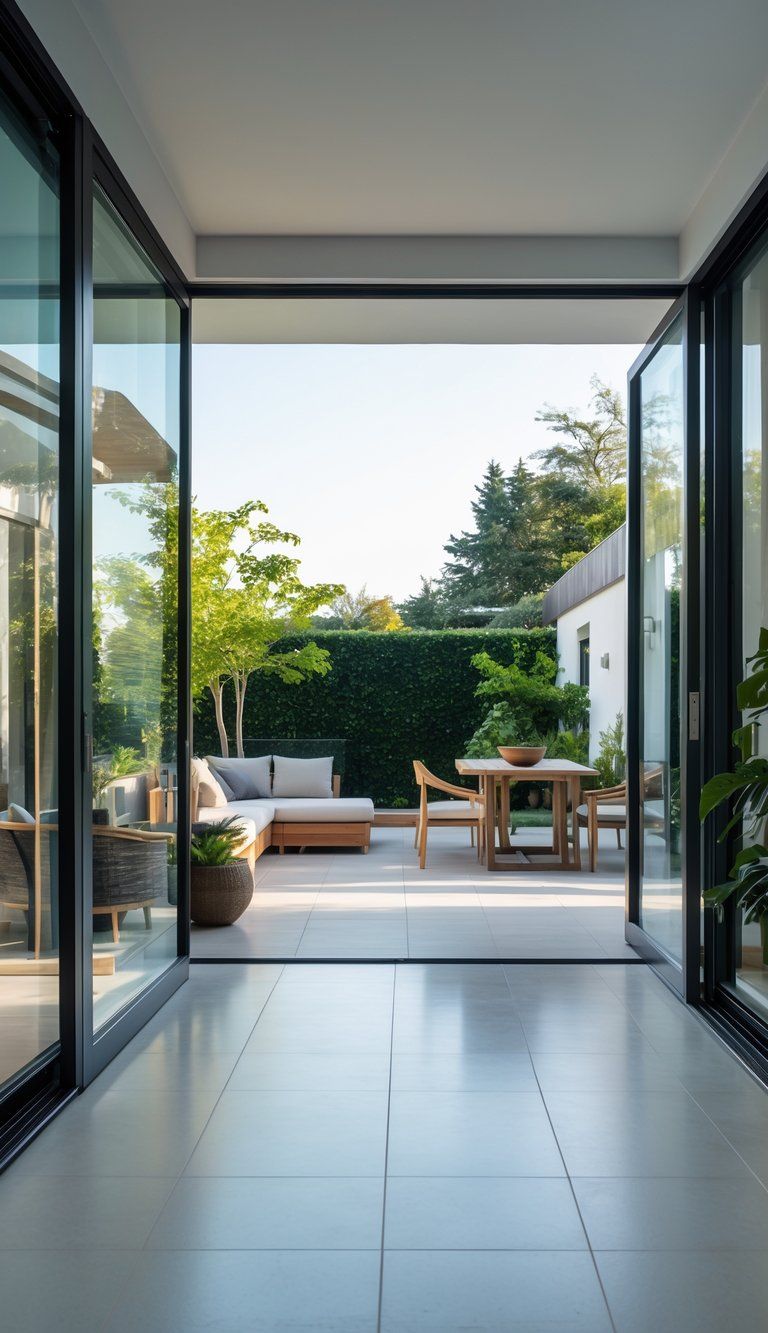
If you want your home to flow naturally from inside to out, you need to pay attention to a few key design elements. When you get this balance right, your space feels bigger and more in tune with nature.
Consistent Design Language
Let your indoor and outdoor spaces speak the same design language. Match materials where you can—if you have hardwood floors, try to echo that color outside with decking or pavers.
Big sliding glass doors or folding walls physically connect spaces and get rid of visual barriers. Suddenly, your outdoor view becomes part of the room.
Carry interior style outdoors with similar furniture shapes. Maybe your living room sofa has an outdoor twin. This kind of repetition helps your eye travel smoothly between spaces.
Lighting matters, too. Use similar fixtures and try to keep the mood consistent inside and out, even after dark.
Creating Functional Spaces
Give your outdoor areas real purpose, just like your indoor rooms. Make clear zones for dining, lounging, and cooking, mirroring your interior layout.
Some things to think about:
- Weather protection: Pergolas, awnings, or umbrellas keep you comfortable
- Comfy seating: Furniture that’s cozy and stands up to the weather
- Outdoor kitchens: Cooking spaces that go with your indoor kitchen
- Heating options: Fire pits or patio heaters for chilly nights
Keep thresholds level between inside and out if you can. If not, use the same materials to make transitions gentle and easy on the eyes.
Add outdoor storage that matches your indoor style. It keeps things tidy and helps your outdoor space feel like a real part of your home.
Selecting a Unified Color Palette
A well-chosen color scheme ties everything together. Pick 3-5 colors that work both inside and out, and use them throughout.
Earthy tones and soft neutrals do wonders as base colors. Think beiges, warm grays, and muted greens—they just work with both built and natural elements.
Stick to your palette with:
- Wall colors that flow from room to patio
- Upholstery and cushions in similar shades
- Accent colors in accessories, inside and out
Natural materials bring their own colors, too. Wood, stone, and plants add organic hues that help connect spaces. Maybe your indoor dining table matches your outdoor teak chairs or a tree nearby.
Keep in mind the seasons—pick colors that look good all year, not just in summer.
Architectural Elements for Smooth Transition
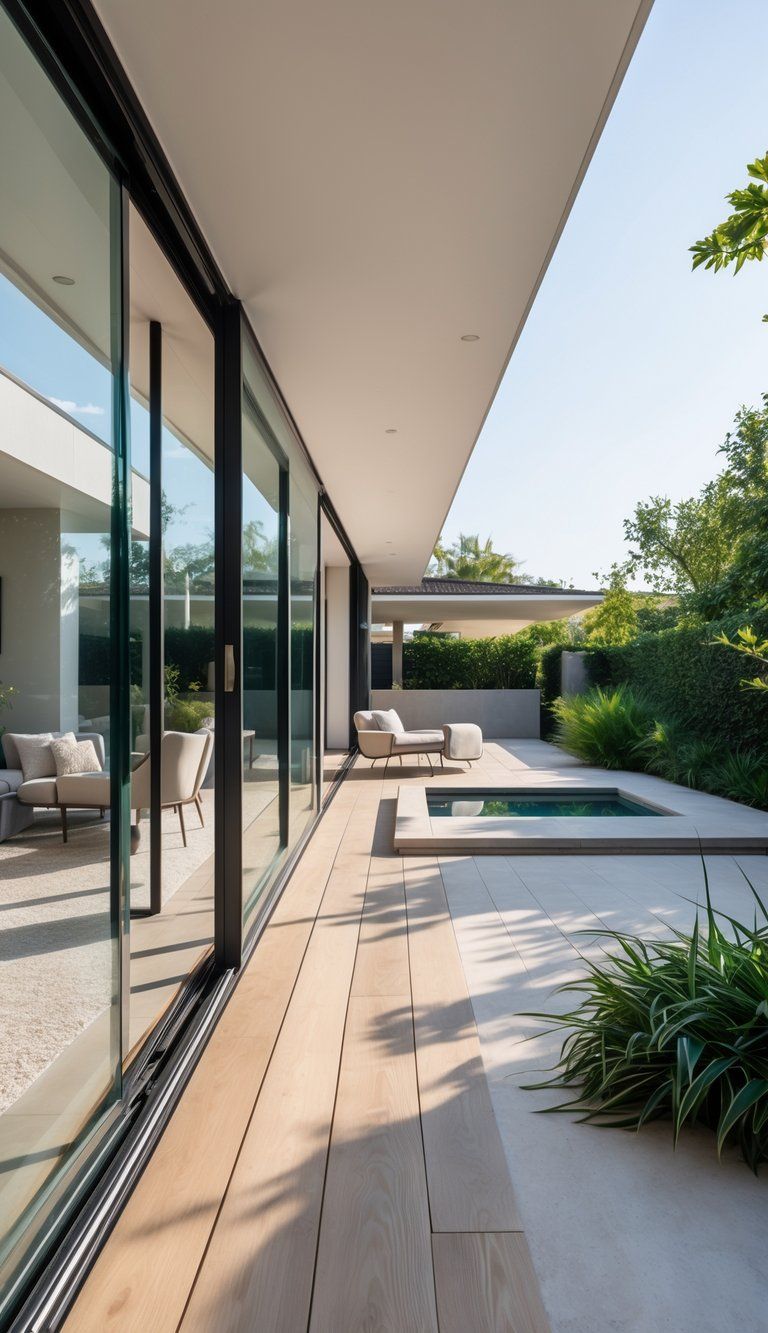
If you want a seamless flow between inside and out, you need smart architectural planning. The right choices can really blur those boundaries.
Utilizing Sliding Doors and Transitional Elements
Large sliding glass doors connect indoor and outdoor areas. These doors can stretch across entire walls, and when you open them up, you get one big space.
Try multi-panel systems that tuck away into the wall. You get a huge opening and no visual interruptions.
Covered patios or pergolas act as transition zones. They bridge the gap between fully indoor and outdoor spaces and add a bit of shelter.
Use matching flooring across the threshold. Maybe you run tile from your living room out to the patio, or pick a deck material that echoes your interior wood floors.
Managing Visual Barriers
Get rid of visual barriers to unify your spaces. Use zero-threshold transitions where floors meet at the same level—no tripping, no awkward lines.
Keep ceiling treatments consistent. Extend your indoor ceiling to outdoor covered areas with:
- Similar materials
- Lighting that flows from inside to out
- Matching colors
Add deep roof overhangs to create outdoor areas that feel like part of the house. They protect you from the weather but keep you connected to nature.
Think about sight lines as you design. Arrange furniture so your eye moves naturally from inside to outside. Avoid tall pieces that block the view.
Optimizing Flooring and Finishes
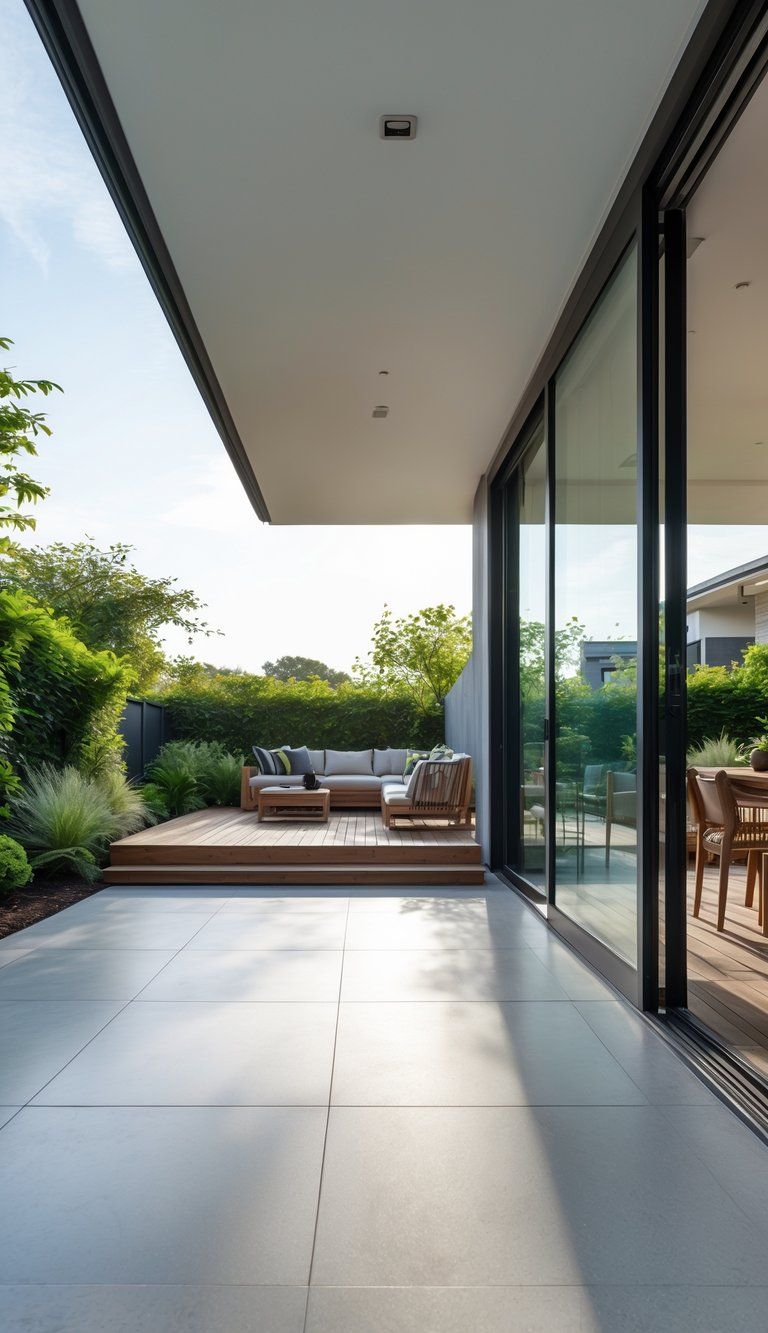
The base of a great indoor-outdoor connection is smart flooring and finishes. When you coordinate these, your spaces just flow better.
Choosing Durable Flooring Materials
Pick flooring that can handle it all. Outdoor-rated porcelain tile works inside and out—it won’t mind moisture, fading, or wild temperature swings.
Natural stone like limestone or slate looks classic and stands up well outside. If you’re on a budget, concrete with decorative finishes can mimic pricier options.
Composite decking like TimberTech gives you the warmth of wood without the headaches. It won’t splinter or rot, and you don’t have to seal it all the time.
Always try to match floor heights between inside and out. Even a little lip can break the visual flow and trip people up.
Coordinating Indoor and Outdoor Finishes
Make sure wall finishes complement each other across the threshold. Some good pairings:
- Plaster walls inside with stucco outside
- Wood paneling indoors and cedar siding outdoors
- Brick accents inside matched with brick patios
Keep color continuity in mind. Use the same—or just slightly weathered—versions of your indoor palette outside for harmony.
Match lighting finishes, too. If you use brass or black iron inside, echo that outdoors.
Don’t forget ceilings. Run wood beams from your living room out to the covered patio for a striking connection.
Feature Materials: Wood, Rattan, and More
Natural materials pull everything together. Wood is a classic—match tones for indoor furniture and outdoor decks or pergolas.
Rattan and wicker work inside and out. Try these:
- Rattan chairs that match your outdoor set
- Woven pendant lights echoed by lanterns outside
- Natural fiber rugs inside and outdoor jute mats
Stone features, like a fireplace indoors and a fire pit outside, link spaces visually.
Fabrics matter, too. Modern performance textiles look and feel like indoor fabrics but shrug off sun and rain. Use similar patterns and colors in both areas for a connected feel.
When you repeat these materials, your spaces feel anchored and naturally connected.
Enhancing Natural Light and Ventilation
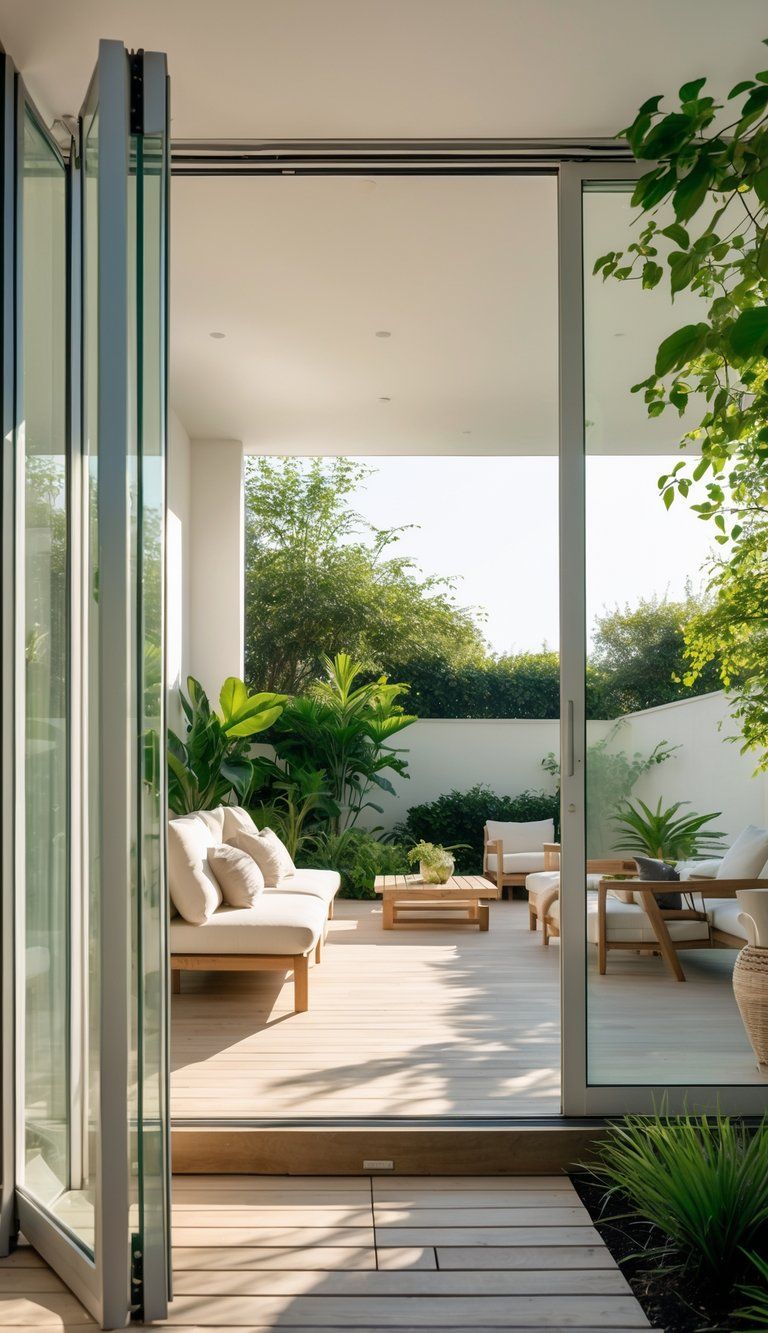
Strong indoor-outdoor connections depend on how well light and air move through your home. A few smart choices can make your rooms feel brighter and more comfortable all year.
Maximizing Light Flow Between Spaces
Big glass doors and windows bring in natural light. Go for floor-to-ceiling windows or sliding doors to let in the most sun. This brightens up your rooms and visually stretches them outdoors.
Use mirrors to bounce light deeper inside. If you put one opposite a window, you’ll double the sunlight in the space.
Pick light-colored, reflective surfaces for walls and floors near transitions. Whites and pale neutrals help light travel further, making the connection between inside and out stronger.
Try skylights or clerestory windows where regular windows won’t work. These overhead options can totally transform a dark corner—plus, you keep your privacy.
Promoting Air Circulation
Cross-ventilation really makes a difference when you want to keep your home cool naturally. Try putting windows and doors on opposite sides of a room to let breezes move right through.
Smart door choices can totally change how air flows in your house.
- Bi-fold doors: You can fold these away and open up entire walls.
- French doors: Swing both sides open for a wide, airy space.
- Sliding doors with multiple panels: Adjust the opening size depending on the weather.
Add ceiling fans in hallways or near entrances to push air between inside and outside. You’ll notice better ventilation and probably won’t need the AC as much when the weather’s mild.
Retractable screens for doorways let in fresh air but keep bugs out. Most new screens almost disappear when you’re not using them, so your view stays open to the outdoors.
Integrating Outdoor Living and Garden Spaces
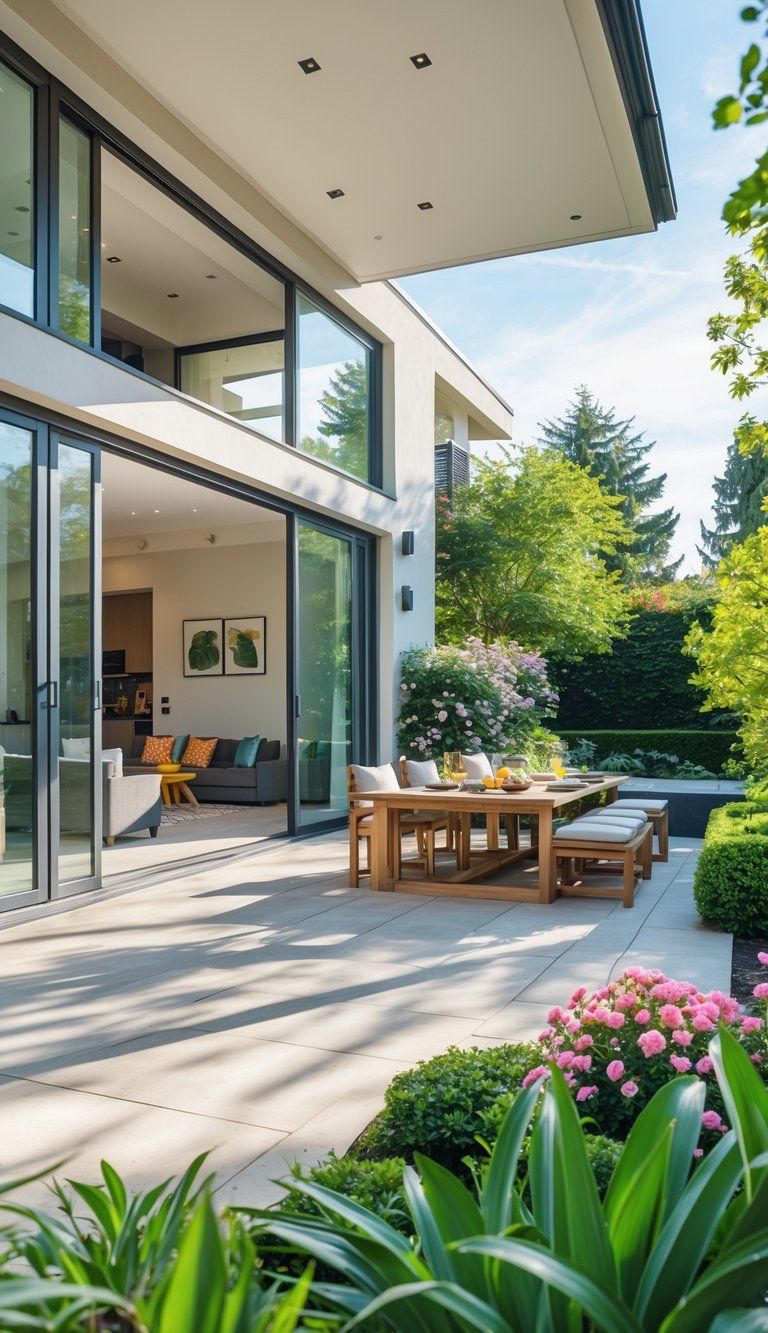
If you want your outdoor space to feel like part of your home, you need to plan it out and pick materials that work together. Mixing the right plants, furniture, and natural touches can totally change your yard into a real outdoor living room.
Designing Outdoor Living Spaces
Think of your outdoor area as another room. Pick furniture that’s comfy but can handle the weather. Outdoor sofas with water-resistant cushions feel just as good as your living room couch, but they don’t mind a little rain.
Set up different zones for what you want to do outside.
- Dining area with a table and chairs
- Comfy lounge spot with seating
- Cooking area with a grill or even an outdoor kitchen
A pergola or awning overhead gives you shade and makes the space feel cozy. It’s almost like putting a roof on your outdoor room, plus you get some shelter from sun and drizzle.
Flooring really matters. You could run your indoor flooring outside, or just pick something that matches. Concrete, stone pavers, and weather-resistant decking all work well and give you a sturdy surface.
Incorporating Gardens and Landscaping
Gardens make the best bridge between your outdoor rooms and the wild parts of your yard. I like to think of plants as the “soft furnishings” for outside.
Layer your plants for more interest.
- Structural plants: Trees and big shrubs create the bones of your space.
- Mid-level plants: Flowering shrubs bring in color and texture.
- Ground-level plants: Groundcovers and small perennials fill in the gaps.
Container gardens bring greenery right up to your chairs and tables. Big pots with statement plants can steal the show, while smaller ones let you play with color wherever you want.
Think about what you’ll see from inside. Put your prettiest plants where you can spot them through windows or doors. That way, you keep the indoor-outdoor connection even when you’re stuck inside.
Plants that smell good or move in the wind make your outdoor area feel alive. Try herbs near your chairs, grasses that rustle, or fuzzy plants you want to touch.
Water Features and Natural Elements
Water features bring movement and soothing sounds to your yard. Even a little fountain can catch your eye and help drown out traffic or noisy neighbors.
Match your water feature to your style.
- Modern spaces: Go for clean-lined fountains or reflecting pools.
- Natural landscapes: Streams with rocks and plants feel organic.
- Small areas: Wall fountains or compact water bowls fit anywhere.
Natural stone grounds your space and ties it to the landscape. If you can, use local stone for a more authentic look and a smaller footprint.
Fire features make it easy to hang outside when it’s chilly. A firepit or fireplace draws people in and anchors your seating area.
Keep in mind, natural elements need some upkeep. Choose water features with sturdy pumps and filters, and pick fire features that follow local safety rules. Done right, these touches will make your outdoor space even better for years.
Designing Outdoor Rooms and Kitchens
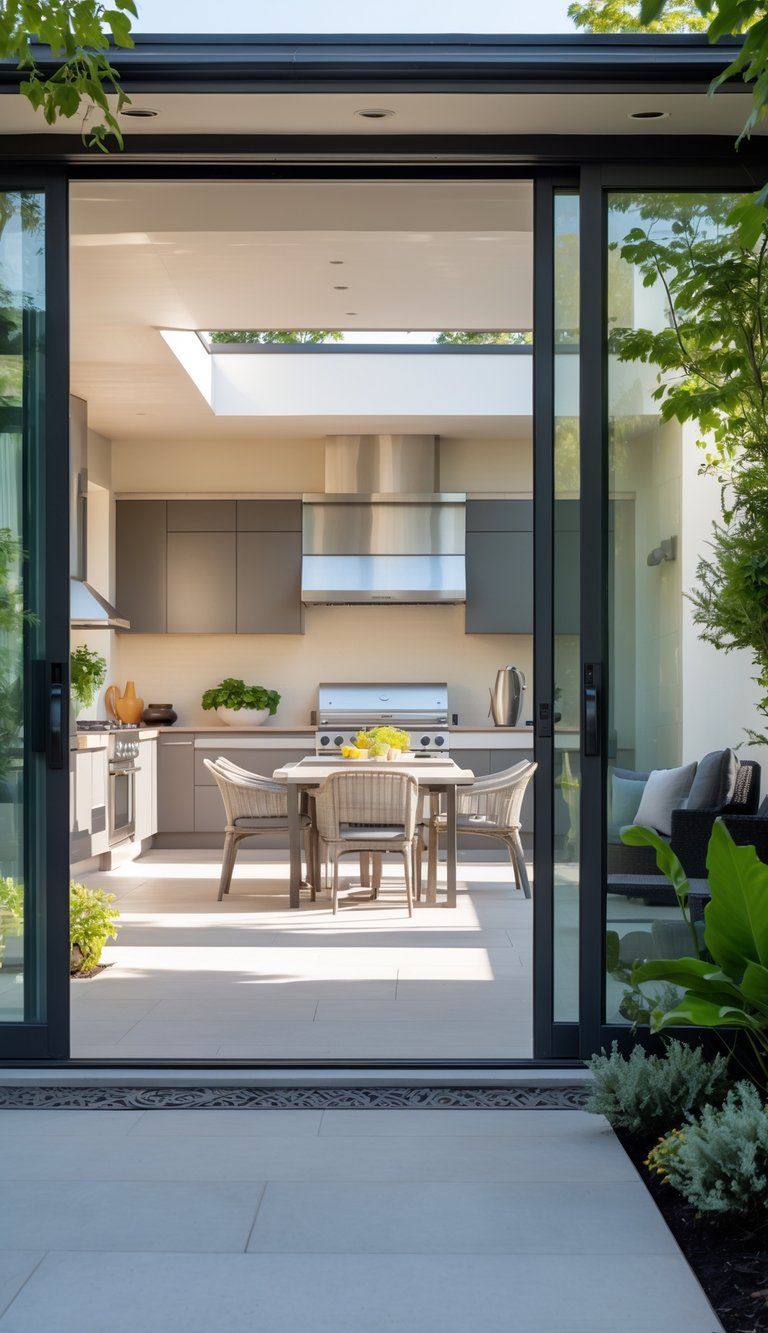
When you create real spaces outside, you expand your home and add a lot to your daily life. Outdoor rooms and kitchens work best when they flow right out from your indoor spaces and give you all the features you actually use.
Planning Outdoor Rooms
Think about how you want to use your outdoor area. Is it for dinners, relaxing, or maybe both? Sketch out zones that feel like a natural extension of your house.
Pick furniture that can stand up to the weather but still fits your style. Outdoor sofas, dining tables, and coffee tables should all be comfortable and tough.
Add a sense of enclosure with pergolas, awnings, or even outdoor curtains. These touches make the space feel more private and sheltered.
Keep your flooring consistent. Using similar textures or colors inside and out helps everything feel connected. Porcelain tiles, composite decking, or stamped concrete are all good options.
Lighting is a game-changer. Mix string lights, wall lights, and pathway lights for both mood and function.
Creating a Functional Outdoor Kitchen
Put your outdoor kitchen near your indoor one if you can. It makes carrying food and supplies so much easier.
Essential Outdoor Kitchen Elements:
- Grill or cooking surface
- Prep counter
- Weather-resistant storage
- Mini fridge
- Sink with running water (if you can swing it)
Pick materials that can handle your local weather. Stainless steel, stone counters, and marine-grade cabinets are all solid choices.
Plan for how people will move between the cooking and eating areas. Leave enough room so no one’s bumping into each other.
If you love pizza or smoking meats, built-in ovens or smokers make your space more versatile. Add them if they fit your style.
Cover your kitchen with a solid roof if you can. You’ll get more use out of it, and your appliances will last longer.
Furnishings and Decor for Seamless Aesthetic Appeal
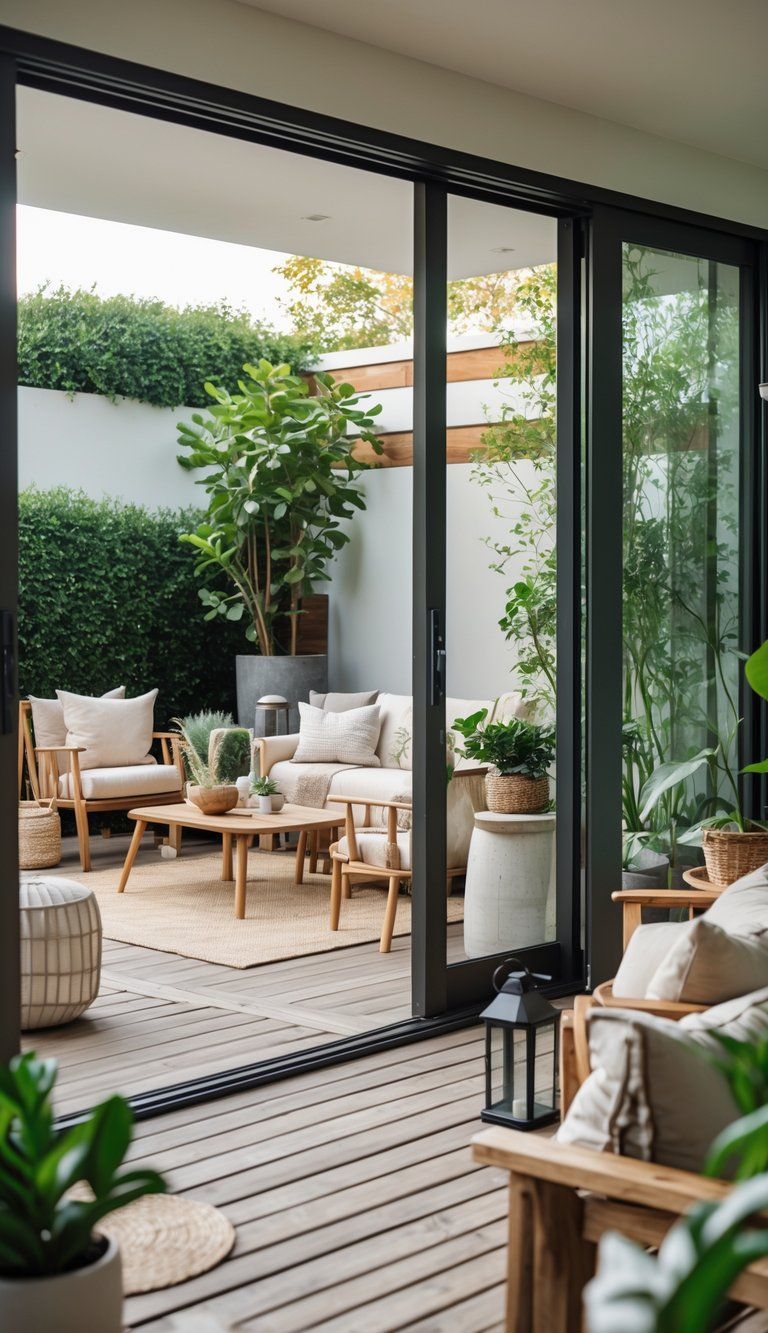
To make your indoor and outdoor spaces feel like one, pick furniture and decor that play well together but still work for their specific environments.
Selecting Outdoor Furniture
Choose outdoor furniture that echoes your indoor style but can survive outside. Teak, powder-coated aluminum, and synthetic wicker all look good and last.
Consider these ideas:
- All-weather upholstery in colors and patterns that tie back to your inside look
- Modular pieces you can rearrange for parties or quiet nights
- Multi-functional items like storage ottomans and nesting tables
Keep the scale in mind. If your outdoor furniture is huge next to your delicate indoor stuff, it’ll look off. Try to match heights and proportions for a smooth visual flow.
Balancing Indoor and Outdoor Decor
Accessories bring everything together. Use similar colors in both areas—maybe take an accent color from your living room and use it for outdoor pillows, rugs, or planters.
Textiles really matter here.
- Outdoor rugs that pick up patterns from your inside space
- Weather-resistant pillows in fabrics that go with your throws
- Curtain panels outside that match or complement your indoor curtains
Layer your lighting outdoors just like you do inside. Use overhead lights, table lamps (solar or battery-powered), and accent lights. This approach keeps the vibe consistent from inside to out.
Plants help connect the two spaces, too. Bring houseplants out when it’s warm, and use similar varieties inside and out for a unified look.
Achieving Cohesive Lighting Solutions
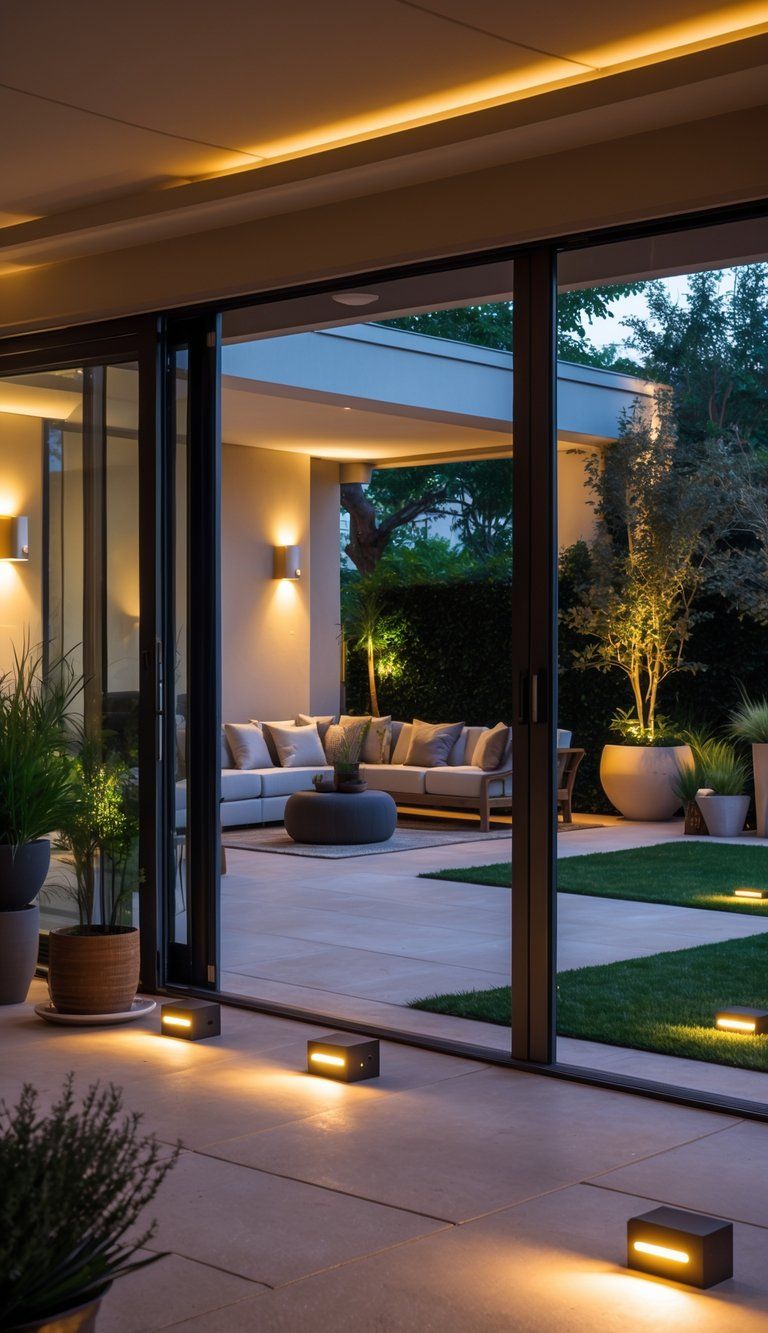
Lighting really ties your spaces together. If you get it right, lighting erases the line between inside and out.
Blending Indoor and Outdoor Lighting
Start with a lighting scheme that works for both spaces. Pick fixtures with styles or finishes that feel related. You don’t have to match everything, but the vibe should feel like it belongs together.
Smart lighting systems make this even easier. You can set up scenes that adjust your dining room lights and patio string lights together with one button. Imagine a “dinner party” mode that gives both spaces a warm, inviting glow.
Layer your light sources—ambient, task, and accent—inside and out. Stick with similar color temperatures (Kelvins) to keep things feeling cohesive. Warm white light (around 2700-3000K) usually works well at home.
Highlighting Outdoor Features
Outdoor lighting can really change the feel of your space once the sun goes down. Try uplighting to show off trees or unique parts of your home—it draws the eye and looks pretty cool from inside too.
Path lighting does more than just help you see where you’re going. Low-profile lights guide your way and make everything feel more inviting.
If you want a modern vibe, add LED strips under steps or benches. They look sleek and make it easier to see at night.
Water features look amazing when you add submersible lights. The glow and reflections at night can be mesmerizing.
For outdoor dining spots, go for adjustable lighting. Brighten things up when you’re cooking, then dim the lights for a cozy dinner.
Don’t forget about light pollution—nobody likes that harsh glare. Use shielded fixtures to keep light pointed down where you need it.
Solar-powered lights are a smart pick if you want to avoid running wires. They’re energy-efficient and you can put them almost anywhere.

